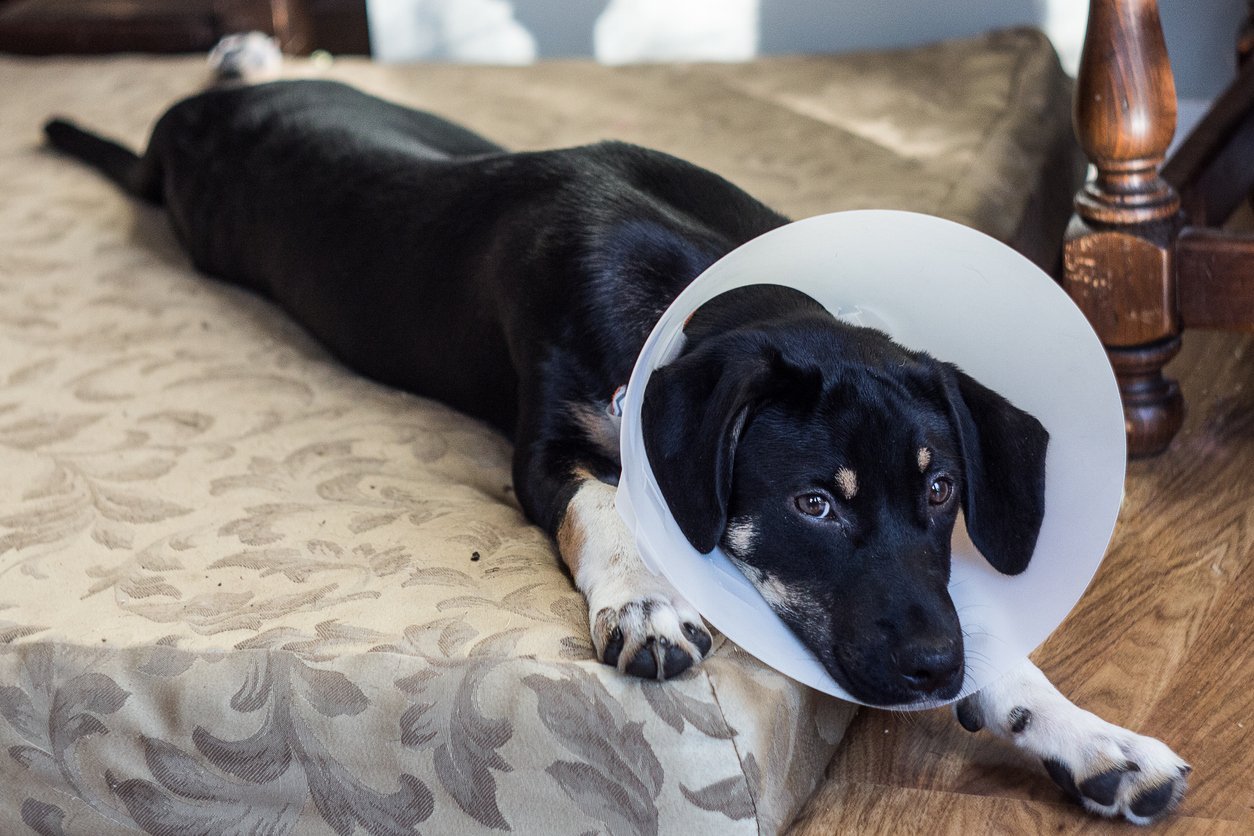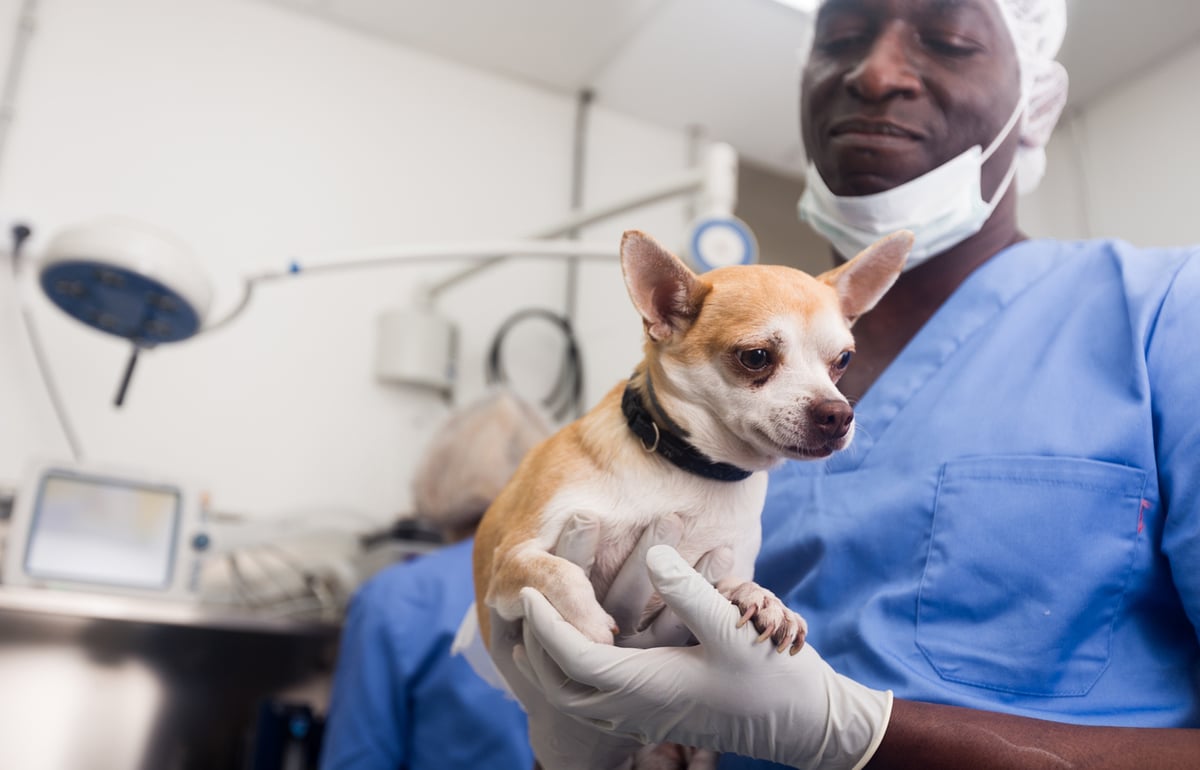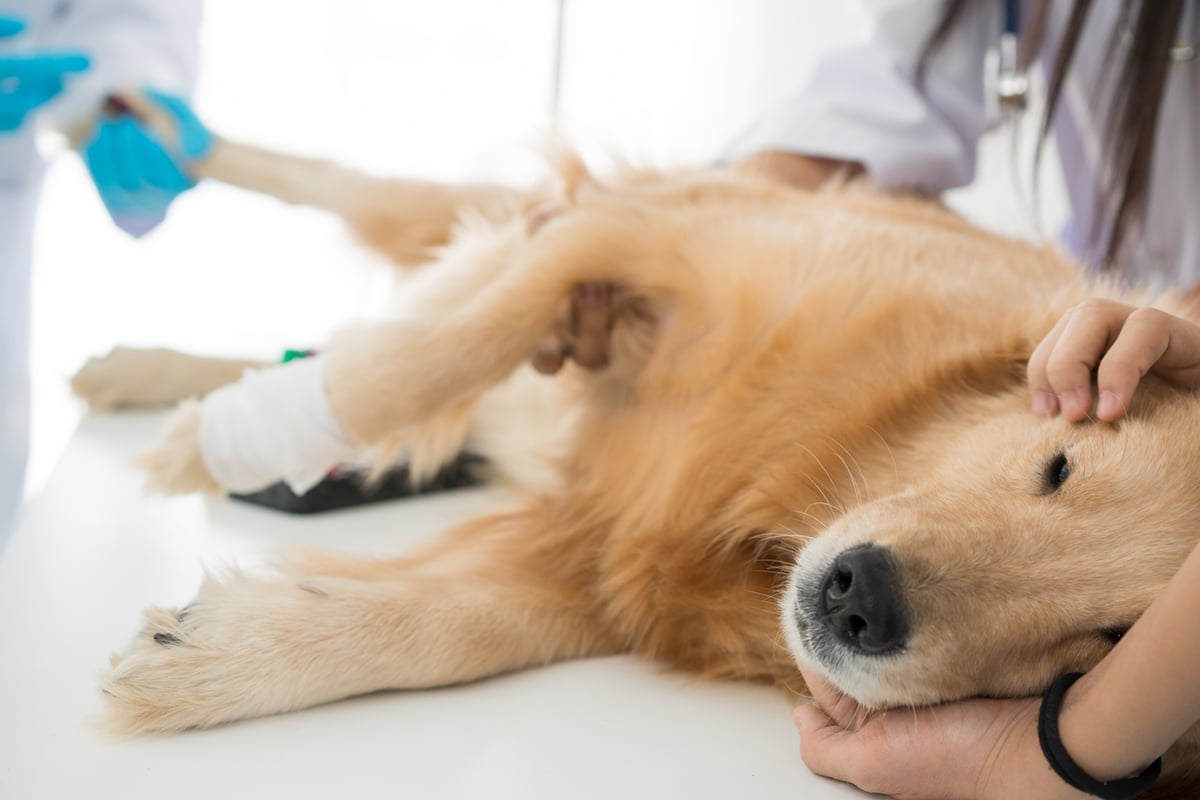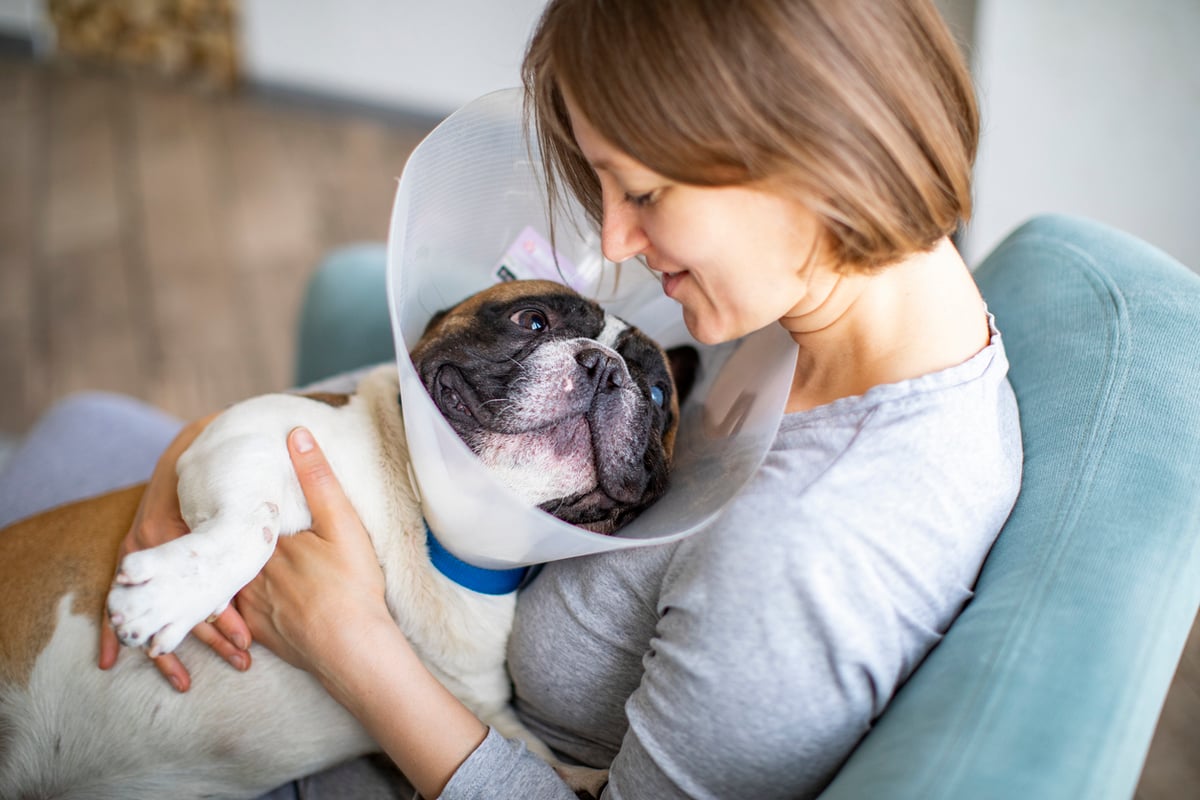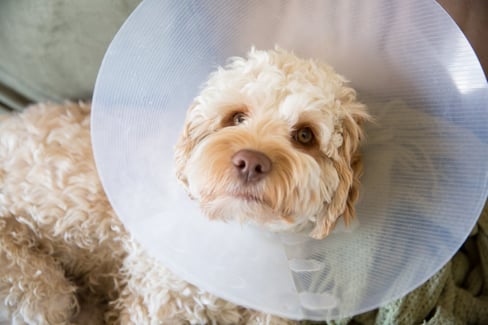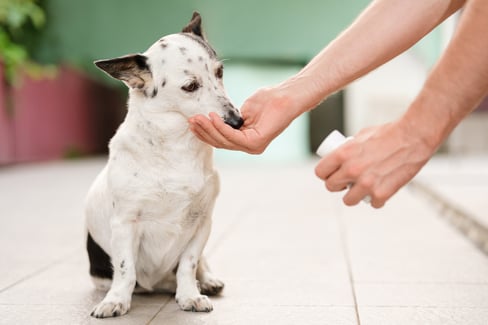Table of Contents
Everyone knows responsible pet owners get their dogs fixed so that unexpected and unwanted litters aren’t born. Getting your dogs fixed can be especially important if your dog’s ancestry has a history of genetic medical conditions.
In males getting your dog ‘fixed’ refers to getting neutered, and in females, it refers to getting spayed.
Just because it’s a commonly-done surgery doesn’t mean that a dog neuter should not be taken seriously. You must know what to expect and what you should do to help your dog recover once he’s been neutered.
So what does it mean to get your dog neutered, and what should you do to help him recover?
This guide on dog neuter recovery will go through:
- The dog neuter surgery process
- Types of dog neuter surgery
- Dog neuter recovery time
- Dog recovery from neuter complications
- Tips on male dog neuter recovery
- Q&A
Let’s begin!
Dog Neuter Surgery Process
The process of neutering a dog involves removing his reproductive organs so that he’s infertile and can’t father any puppies. If you’re unfamiliar with this process, it can seem cruel. However, it can be an important part of responsible pet ownership, as it helps stop unwanted puppies or puppies with health issues from being born.
A male dog should typically be neutered between 6–9 months of age.
You’ll have to book an appointment for the surgery in advance with your veterinarian. This could be brought up and discussed in your first few appointments with your new little puppy. Your vet will better know the best time to do the surgery and how far in advance you’ll need to book it. (Different vet’s offices will be at different levels of busyness and involve different planning timeframes.)
Getting back to the surgery itself, there may be things you need to do to prepare your dog for the surgery. Talk to your vet about what they suggest. The ASPCA (The American Society for the Prevention of Cruelty to Animals) recommends only giving your dog a small snack in the morning on the day of surgery and keeping your dog inside so he can’t eat something you won’t see.
After the surgery, your dog will likely only need to stay overnight with the vet for one night (depending on their surgery time). You’ll drop him off and pick him up the next day, good as new.
But what about the surgery between you dropping him off and picking him up?
Types of Dog Neuter Surgery
There are two types of surgery to neuter a dog:
- Open castration
- Closed castration
The difference between the two types of surgery is the method of removing the reproductive organs. The result is still the same.
With both open and closed castration, an incision will be made to your dog's abdomen near his genitals to remove the reproductive organs. So, no matter which surgical method is used, your dog will go home with stitches.
Open Castration
Open castration is when an incision is made in the membrane covering the testes, as The Spruce Pets explains. The testes, spermatic cord, and ligaments can then be cut out of the dog carefully from there, typically done in several different cuts.
Closed Castration
Closed castration is when that incision isn’t made. Instead, the reproductive structures are removed at once. However, the above-cited The Spruce Pets article mentions that a couple of knots are typically tied to prevent bleeding.
Note: According to Veterinary Practice News, there isn’t necessarily enough evidence to decide which technique is better. However, open is typically recommended for large and closed small dogs.
Dog Neuter Recovery Time
There’s no ‘one size fits all’ answer to the question, “How long does it take for a dog to recover from being neutered?”
Dogs will take different times for neuter surgery recovery. However, your pup should fully recover in about two weeks, the complete dog neutering recovery time.
We’ve outlined the general dog neuter recovery timeline in the table below.
| Time Range of Recovery from Neutering |
Description |
| 6-9 Months of Age |
The neutering surgery happens |
| First Night |
Your dog will likely stay overnight at the vet’s |
| Day After Surgery |
You’ll be able to bring your dog home, potentially with a cone around his head so he can’t reach his stitches, and with a prescription for pain medication |
| First Couple of Days |
Rest for your pup to recover from surgery and so he doesn’t aggravate the stitches, incisions, etc. incurred from the surgery |
| First Week |
Low activity for your pooch, so he doesn’t aggravate the stitches, incisions, etc. incurred from the surgery |
| After About Two Weeks |
Full recovery of your pooch, cone to be removed, and stitches are either dissolved or removed. |
This is just a general breakdown of small and large dog neuter recovery. You can discuss the specifics of recovery with your vet. If your little boy appears to be in more pain than he should be, is not acting himself a few days post-surgery, isn’t properly using the bathroom, or if anything else appears not quite right with the recovery process, consult your vet.
And that brings us to our next section on dog neutering recovery healing stages.
Neuter Healing Process In Stages
Male dogs can be particularly energetic and playful. Though non-neutered male dogs are notoriously more territorial and hyperactive, you may find your male dog is still easily excitable just a few days after their dog neuter recovery.
Dealing with neutered dog recovery can be challenging; you want to make sure your pup is well-rested and comfortable to allow proper healing. Dog spay recovery and dog neuter recovery have similar healing processes and recovery recommendations.
If you’re wondering “how long is neuter recovery”, male dog neuter recovery typically happens in stages:
- 24-28 hours after surgery
- The first week after surgery
- The second week after surgery
Here is an overview of what you can expect for dog neuter recovery day by day, in the neuter healing stages.
Stage #1: 24-48 Hours After Surgery
Your dog has had major surgery requiring general anesthesia. General anesthesia usually takes between 24-48 hours to wear off. During this time post-surgery, your dog will be drowsy, low energy, and lethargic.
Follow these home care steps in the first stage of recovery after neutering:
- Create a confined and comfortable space where your dog can rest in peace; choose a kennel or small room away from other animals.
- Keep your dog indoors except when going to the bathroom; consider carrying them down steps.
- Monitor the surgical site for any abnormal oozing or swelling; continued bleeding, puss, or heat are signs of infection
- Stick to a schedule for pain medication; missed medication causes intense suffering, and doubling up on doses may cause an overdose.
Your dog may not have an appetite for the first 24 hours following your surgery. If they do not eat after 24 hours of the dog neuter recovery period, or if they have diarrhea or vomiting, call your veterinarian.
Stage #2: First Week After Surgery
As your dog is healing, you must make sure they do not lick or chew at the surgical site. Purchase an Elizabethan collar (E-collar) or a surgical onesie to prevent your dog from irritating the wound. Vets recommend keeping the collar on until the surgical site is fully healed, approximately 7-10 days after the surgery, for the ‘dog neuter recovery time cone’ period.
Monitoring your dog’s diet for the first week during neutering recovery is important. Avoid junk food, table scraps, or milk products, and stick to healthy meals for at least seven days. Do not try any major dietary changes, such as a raw food diet for dogs while your pup recovers; save the weight loss journey until they return to their spunky selves!
Limit your dog’s activity for the first 7-10 days post-surgery. During this dog neuter recovery period while the surgical site is healing, limit exercise to short walks and monitor yard time.
Stage #3: Second Week After Surgery
Following the first week of surgery, your pup may seem to return to normal with their behaviour; however, it is important to allow a full two weeks to complete the full recovery time for dog neuter. Dogs and cats have internal sutures and external skin glue that support tissue as it heals; strenuous activities will disrupt this healing process.
Continue to avoid the following activities during the second week after the surgery:
- Bathing
- Swimming
- Running
- Jumping
- Walks off-leash
- Play with other animals
Dog Recovery from Neuter Complications
Having your dog neutered is a relatively safe surgery. But, it is still a surgery, and sometimes complications do happen. That doesn’t mean your dog won’t still recover, though. The recovery process might just look a bit different. These complications can include
- Cryptorchid dog neuter recovery
- Infection dog neuter recovery
- Scrotal bruising and/or swelling
- Hemorrhage and/or bleeding
Cryptorchid Dog Neuter Recovery
Cryptorchidism is when a dog’s testicles have not properly dropped into the scrotum, so they remain located in the abdomen. Neutering a dog with cryptorchidism is still possible, although PetMD states it’s common to hold off neutering until the dog is a year old to give the testicles time to drop.
How the testicles were found to be removed may affect the recovery process of your pooch. However, if all goes to plan, the recovery should not be much different than that of a regular dog neuter recovery.
Infection Dog Neuter Recovery
Surgeries always come with the risk of infection, so ensure you monitor your dog for any signs of infection. Signs of an infection can be
- Redness
- Swelling
- The area is sensitive to the touch
- Pus
- Your dog is acting lethargic, not like himself (or otherwise suggesting he’s in pain).
The easiest area to check for infection is around the stitches. The skin in that area should look healthy. There should be no redness, swelling, crustiness, etc.
However, that’s just the visible stitches near your dog’s genitals. You’ll still need to monitor your dog for any signs of an internal infection, which may have less obvious visual clues for you to pick up on.
Scrotal Bruising and/or Swelling Dog Neuter Recovery
There’s a 50% chance that dogs over 50lbs will develop scrotal bruising and swelling, developing a hematoma due to the incision site bleeding and leaking fluid into the scrotum.
Typically, this ends up being an ultimately harmless occurrence (which makes sense if it happens about half the time in a certain size of dog).
Although it is usually nothing to fear, clearing up on its own (although it can be aided with ice), there does become a time when you should take a trip back to the vet’s to get it looked at if the swelling hasn’t gone down (the same Pet Resource article suggesting after 24 hours). The article even recommends not feeding your dog in case surgery is required.
Hemorrhage and/or Bleeding Dog Neuter Recovery
The definition of hemorrhaging is when a large amount of blood pours out of your blood vessels.It can happen in dogs, just like in humans (and other animals), and, more to the point, it can happen to your dog after he’s been neutered.
Hemorrhaging typically occurs after neutering because the internal ligatures weren’t secured properly and have slipped out of place. The article also suggests that this may require additional surgery to locate the source of the bleeding.
However, for that to be possible, you’ll have to know how to recognize the signs of hemorrhaging in your dog. Some of these symptoms, like lethargy, may be similar to an infection. But other features, like pale gums, as noted in the article, will be telltale signs of internal bleeding.
Tips on Male Dog Neuter Recovery
Your dog will probably recover from his neutering without complications, including any of the others mentioned previously. However, during the recovery time for neutered dogs, there are things you can do to prevent any further complications or to help facilitate an easier recovery for your pup. Some of our tips for dog neuter recovery are
- Follow your vet’s recovery plan
- Take it easy on the exercise
- Keep your dog away from his stitches
- Watch for signs of any issues
- Keep your dog strong with a balanced diet and supplements
Follow Your Vet’s Recovery Plan
Our first tip is to simply follow the advice your vet provides you for your dog’s recovery. No one will know the intricacies of your dog’s surgery better than the one who performed it, so trust your vet's plan. If, for some reason, your vet doesn’t give you any expectations for your dog’s recovery, ask when you go to pick him up. You can even ask if you should be looking for anything that differs from the general timeline we’ve provided in the previous table.
If you aren’t able to or fail to comply with your veterinarian’s instructions for whatever reason, let your vet know. This way, your vet can give you another action instead and/or tell you what to be careful of or look out for now that you’re going off-script.
Your vet is probably busy, so it’s important not to bother them over every little thing. But it’s also important that your dog recovers from his surgery, so don’t be afraid to reach out to your vet if you have questions or are unsure about something.
Take It Easy on the Exercise
Your dog just had surgery and will still have stitches and internal ligatures. So make sure your dog takes it easy during recovery. He may be in pain, anyway, and be feeling more low-energy than usual at first, although that shouldn’t last the full duration of his recovery.
But even when he starts to get his energy back, ensure you don’t let your pup engage in reckless activities that could re-open incisions, tear stitches, damage ligatures, etc. If your dog engages in these activities, it might make a trip back to the vet to repair the damage necessary.
So, for the ease of a seamless recovery, it’s best only to let your dog engage in lighter, less intensive exercises. For the first couple of days, this should include only rest, but after that, you can incorporate low-energy activities into your dog’s routine. No running, leaping, bounding, jumping, pouncing, twirling, swimming, etc.
Especially no swimming, as you really shouldn’t be getting the stitches wet unless given a cleaning routine for them by your vet.
Keep Your Dog Away from Stitches
Likely, your dog will come home with a big cone on his head so that he can’t lick at his stitches. This is good. Leave that cone on, even if you feel it looks silly or impedes your dog’s movement. It’s there for your dog’s good. Because if he begins licking his stitches, he risks getting bacteria that could cause an infection in the incision.
Keep your dog away from his stitches in other ways, too. Don’t let him scratch at the stitches, for example. Not only does this run the same risk of infection, but it can also harm the stitches or the healing incision.
As a general rule, leave the stitches alone unless instructed to clean the area by your vet. You want the area to have as little risk of infection or re-opening as possible, as both can impede healing.
Watch for Signs of Issue
One of the best tips we can give you is to be vigilant. Your dog will probably be fine but watch him anyway for any signs of an issue. You don’t want to become paranoid and see issues that aren’t there. But that’s what this guide is for! To help you know what to look for.
Look for signs of infection, hematoma, hemorrhaging, and other medical issues, but also make sure the rules are followed for the smaller stuff. Ensure he’s not trying to jump in ponds and get his stitches wet, scratch at his stitches, get his cone off and lick them, etc.
The more vigilant you are, the better you’ll feel. You’ll be armed with knowledge about what to look for, and you’ll be able to tell that your dog is fine if he’s fine and get prompt medical attention if something does happen.
Keep Your Dog Strong with a Balanced Diet and Supplements
A healthy, balanced diet is always important for your dog, especially after an ordeal like surgery. There’s a chance your dog may be too stressed to eat or have an upset stomach and not want to eat when you first bring him home. But, shortly after that, you’ll want to make sure your dog is getting the nutrition he needs to ensure he’s in good health with a strong immune system so he can heal in no time.
The food you feed your dog is a large part of this, but you can also add supplements to the mix. Different types of supplements will target different things you may want a boost for.
Here at Integricare, for instance, we offer two types of joint supplements for pets, including dogs.
- TRI-ACTA includes the cartilage repairing and breakdown prevention ingredients of glucosamine for dogs, MSM, and chondroitin in a proactive way for younger dogs.
- TRI-ACTA H.A. includes those ingredients plus hyaluronic acid for joint lubrication to help speed up the recovery process from surgeries and to aid highly active or older pets with mobility issues.
Our supplements don’t include any filler ingredients, so your dog would just be getting the good active ingredients in a condensed form that is easy to hide in their food.
TRI-ACTA H.A. for Pets
Our maximum strength formula is optimally designed to accelerate the formation of cartilage, minimize inflammation, expedite the healing process, and improve joint conditions.

However, if you want more information on great food to pair with your supplements for dogs, check out our article Top 10 Best Canadian Natural Dog Food & Supplements.
Q&A
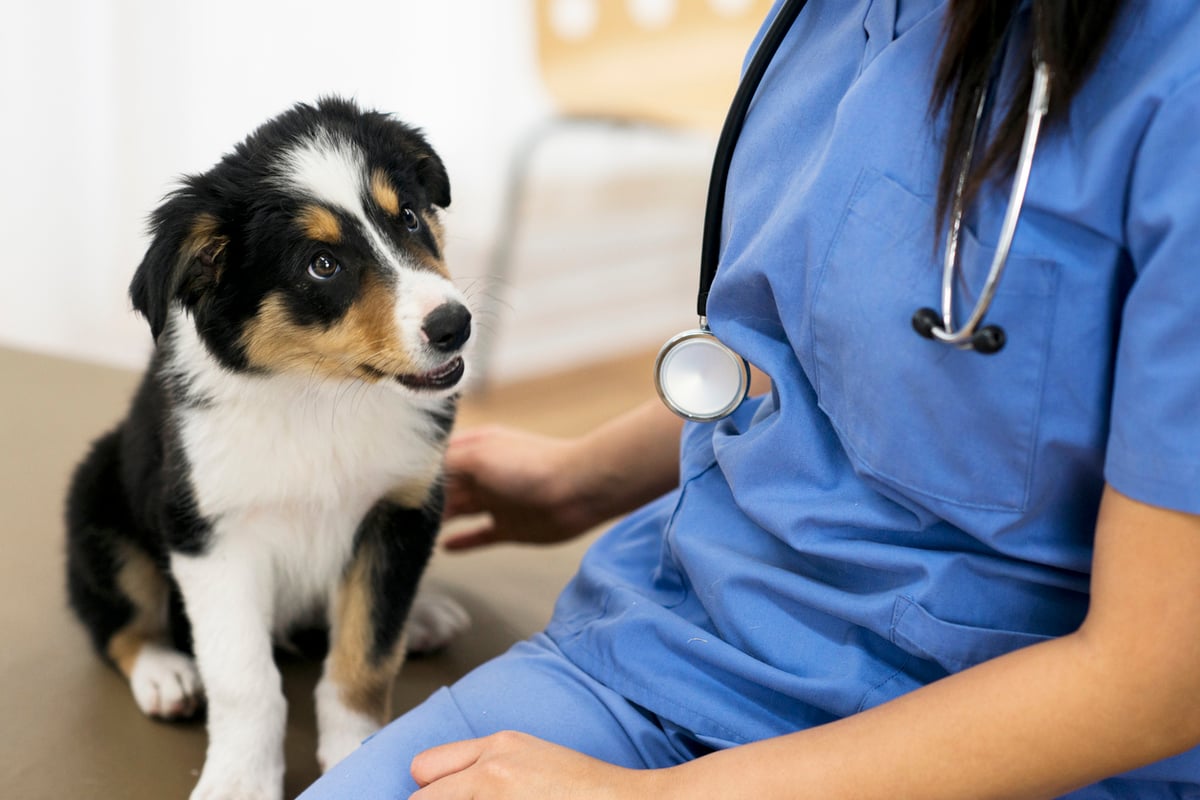
Why do dogs need to be neutered?
Technically, dogs don’t NEED to be neutered. However, it’s highly recommended as a part of responsible ownership unless your dogs are going to be used for breeding (which should only be done if all the responsible measures have been taken).
Otherwise, it is often recommended to neuter your dogs to prevent them from fathering litters of puppies that may suffer from health issues or be unable to be homed.
We’ve laid out a table below with the pros and cons of neutering your dog.
| Pros |
Cons |
|
|
Why is Dog Neutering So Expensive?
The price may vary depending on where you are and the veterinarian’s office you go to. However, it is a surgery typically involving your pooch staying the night.
If you’re looking for possible help covering the costs, consider getting pet insurance, which you can learn more about in our article Pet Insurance – What You Need to Know.
Spay vs Neuter Recovery
It is a common misconception that pet owners think because a neuter surgery is a shorter procedure, it will have a shorter healing time than a dog spay recovery. However, a dog spay and dog neuter recovery takes up to two weeks to fully heal and should be monitored in similar fashions.
Dog Neuter Recovery How to Stop Licking
Purchase an Elizabethan collar (E-collar) or a surgical onesie to prevent your dog from irritating the wound during the neuter recovery time. Keep the collar on until the surgical site is fully healed, approximately 7-10 days after the surgery.
In Conclusion
So, there you have it. That’s everything you need to know about the neutering and dog neuter recovery process for your dog.
When you get your dog neutered, you’ll know exactly what to expect. And with our tips of
- Follow your vet’s recovery plan
- Take it easy on the exercise
- Watch for signs of any issues
- Keep your dog away from his stitches
- Keep your dog strong with a balanced diet and supplements
Hopefully, you’ll be able to direct your dog to an easy, complication-free recovery.
Check out our other blog posts and resources for more information on looking after your dog (or other pets).
And don’t forget to shop our pet supplements to keep your dog’s joints strong here.
TRI-ACTA H.A. for Pets
Our maximum strength formula is optimally designed to accelerate the formation of cartilage, minimize inflammation, expedite the healing process, and improve joint conditions.

Newsletter Signup
Subscribe to our newsletter to receive the latest news and exclusive offers.
.jpg?height=2000&name=Cliick_Integricare-DISPLAY-REVISEDV2%20(1).jpg)
Proactive & Therapeutic Joint Supplements
When given daily, Integricare joint supplements recover bone and joint injuries faster and help prevent mobility injuries from happening in the first place.

